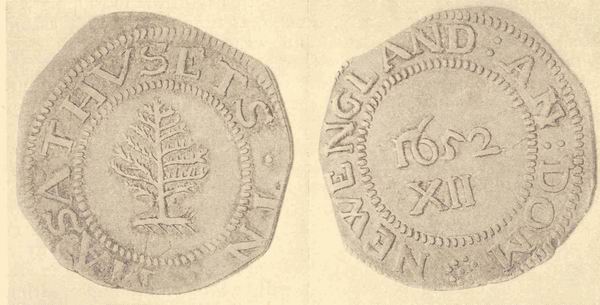|
1999-2003 (Return to Web Text-ures) |
Click Here to return to |
|
1999-2003 (Return to Web Text-ures) |
Click Here to return to |
FIRST NEW ENGLAND COINAGE
“After a little keeping in scoole, I was taken to help my father plant corne, which I attended for seven yeares together. I then fell to learning by the help of my brother, and to practising the trade of goldsmith, and was able to get my living by it.”—John Hull, in his Diary.

From an
original.
Collection of the Massachusetts Historical Society.
THE PINE
TREE SHILLING, 1652.
Enlarged two and one-half times.
When Hannah Hull’s father, on her marriage to Samuel Sewall, placed his daughter, as tradition says, in one of the scales and heaped in the other silver New England shillings until the scales balanced, the wedding present amounted to £3,000,—only a portion of the wealth that John Hull gathered besides his “living” as master of the first mint in New England.
Owing to the increase in trade in the Colony and to uncertainties in England, Massachusetts in 1652, for the purpose of preventing fraudulent money, erected “a mint for coining shillings, sixpences and three-pences.” The General Court, accordingly, authorized John Hull “a silversmith” and Robert Sanderson, for “melting, refyning, and coining of silver.” Massachusetts was the only colony that coined money, and the first pieces had the initials of New England on one side and Roman numerals denoting the value on the other. Afterwards it was ordered by the General Court that all moneys should have the following inscription: “Massachusetts, and a tree in the centre on one side, and New England and the year of our Lord on the other side.” The mint-house was located on Mr. Hull’s estate; it was not a pretentious building, the order for it calling for a wooden edifice, sixteen feet square and ten feet high. It was the subject of common remark in its day: “Twelve pence laid out on the purse and only six pence in it.” It is related that not long after the starting of the mint Charles II in great wrath questioned Sir Thomas Temple, the first agent officially despatched by the General Court to London, as to why this Colony presumed to invade His Majesty’s rights by coining money. Virtually, Sir Thomas said: “The colonists have but little acquaintance with the law. They are simple folk, meaning no ill, and they thought it no crime to make money for their own use.” Sir Thomas took a “pine-tree” shilling from his pocket.
“See, your Majesty, here is the coin.”
On one side of the piece had been struck a tree which, though there is no record of its identity at the time, has later been called a pine-tree. It may, however, have been any New England bush.
“What is that tree—what does it mean?” said King Charles, frowning.
“That, your Majesty,” said Sir Thomas, “is a royal oak. Your colonists, not daring to put your Majesty’s name on the coin, have struck thereon the emblem of the oak, which preserved your Majesty’s life.”
“They are a parcel of honest dogs,” cried Charles, at once restored to good-humor.
How the coins came to be known as pine-tree shillings cannot be definitely traced. The official records speak of the drawing as a “tree,” the pine-tree itself not appearing officially until it was impressed on the seal of the General Court, where a pine-tree appears on each side of the Indian.
The date—1652—for thirty years remained unchanged. John Hull’s share in the profits of the mint was fifteen pence out of every twenty shillings. He rapidly amassed a fortune, and the General Court, possibly discovering this, sought to be released from the contract; but John Hull refused, and continued for some years to add to his coffers, even after giving his daughter Hannah £3,000 for a wedding dowry.
The “pine-tree” shillings circulated up to the time of the Revolution, and after that they were collected or preserved in museums. With the exception of Maryland, where Lord Baltimore struck off a few silver coins, Massachusetts is the only one of the thirteen colonies that had a mint before the Revolution.
Hull Street in Boston, which was laid out through John Hull’s pasture, is named for him and was given to the city by Judge Sewall and his wife, Hannah, of pine-tree-shilling fame, on condition that it should always be called by the mint-master’s name.